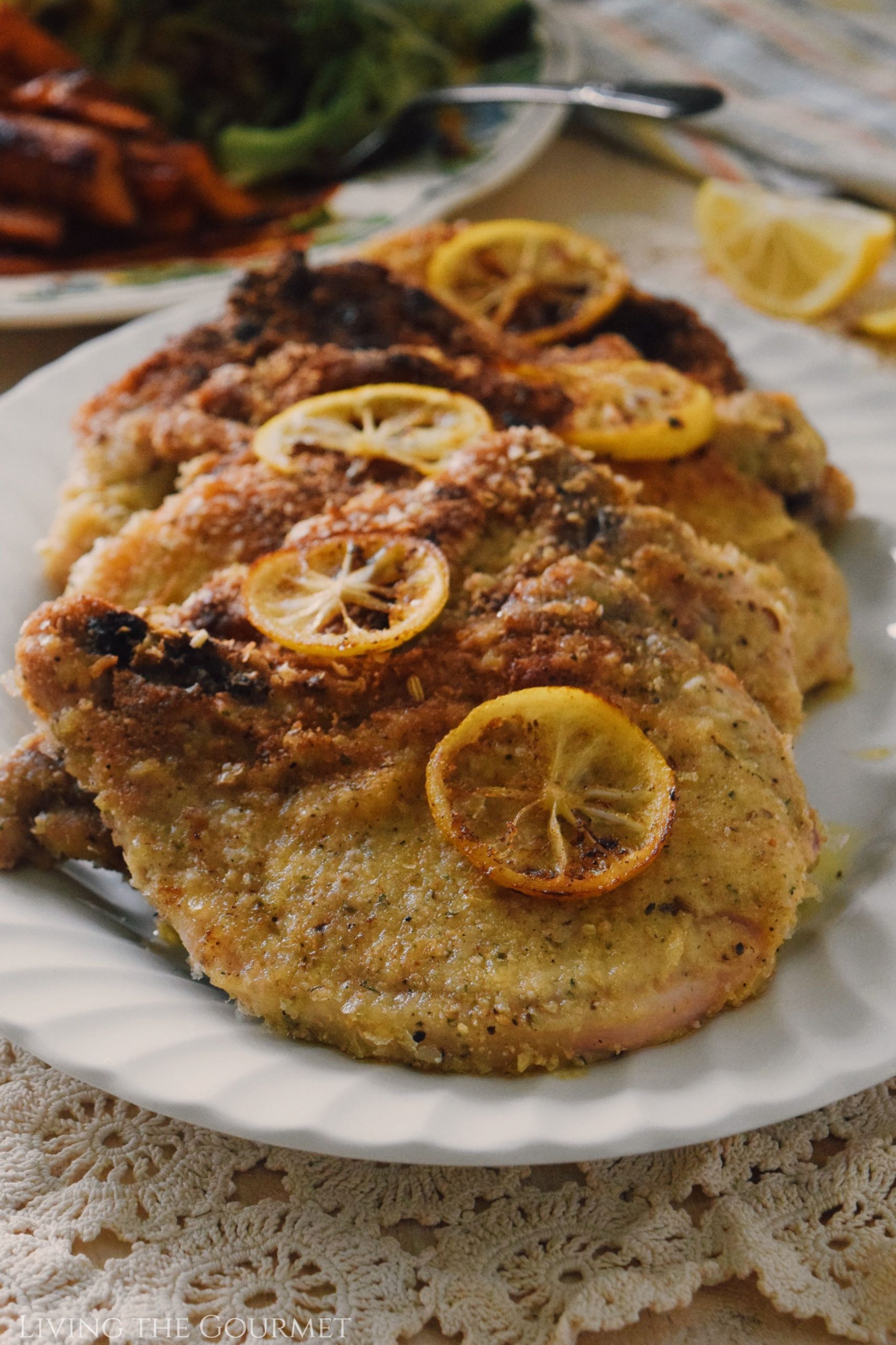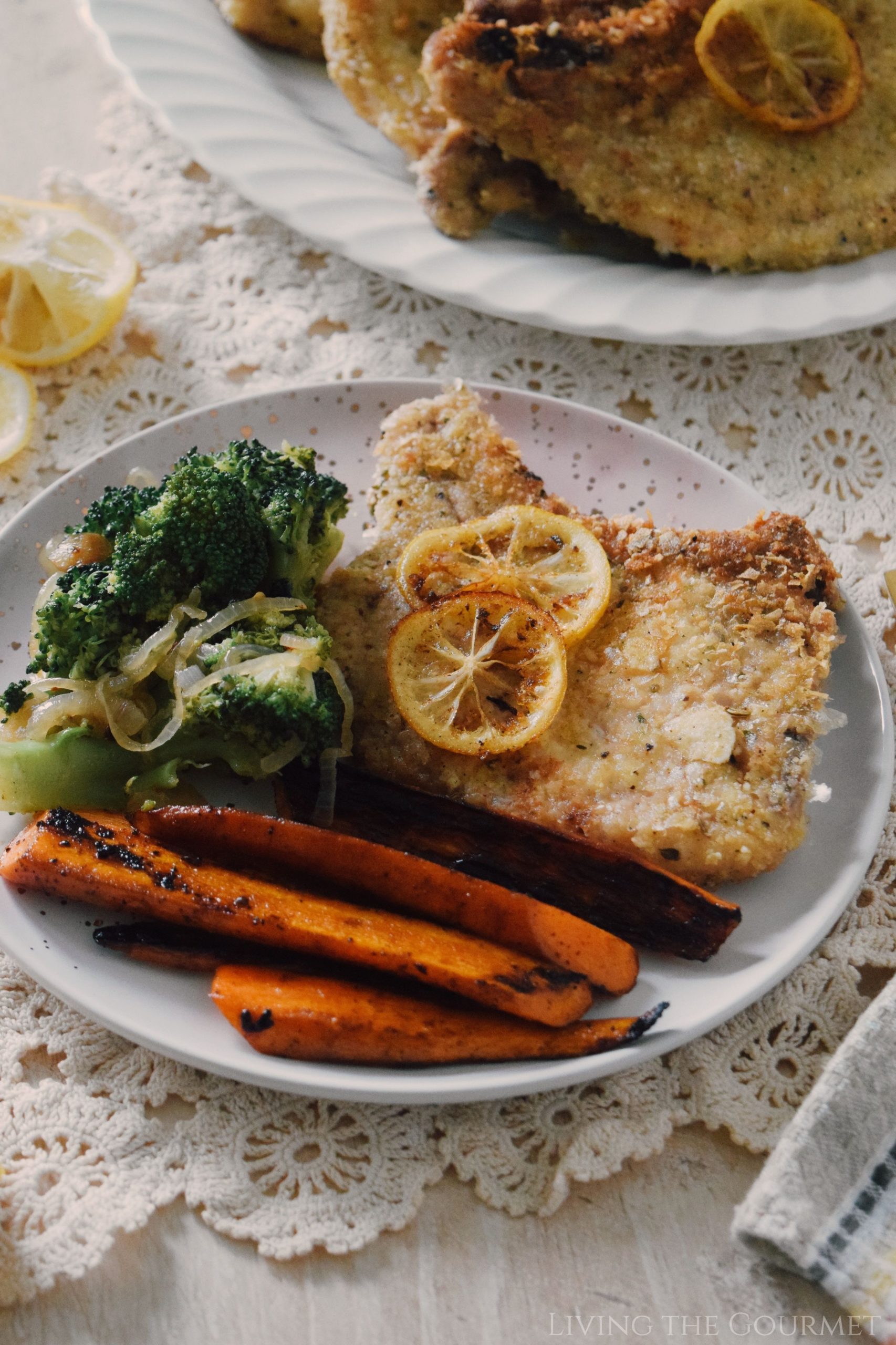Today we’re preparing pan-fried pork chops, which are great as a satisfying weeknight meal. We’ll be battering them in a mix of seasoned breadcrumbs with fennel, garlic, and pepper, and then frying them stovetop to achieve a crisp outside and a moist and tender interior. No dry pork chops allowed here.
1) Italian Style Breadcrumbs. These are probably the most common type of breadcrumbs on American store shelves after ‘regular’ breadcrumbs, but what are they ‘really?’ Basically, they’re ‘regular’ breadcrumbs but with some combination of dried basil, oregano, and parsley, along with a copious amount of salt and black pepper – and that’s pretty much it, though some brands may include red pepper as well. Oddly, Italian-style breadcrumbs are rarely toasted in olive oil, and even when they are the olive oil is usually a cheap ‘light’ olive oil.
2) Oil For Frying – Olive Oil or Vegetable Oil? The rule of thumb is this – olive oil gives superior flavor and health benefits, but ‘only’ when cooking at lower temperatures of no more than roughly 350 degrees Fahrenheit, or when barbecuing over ‘gentle’ flames. Use vegetable oil for pretty much every other cooking application. The reason is that most olive oils have a relatively low ‘smoke point,’ which is the temperature at which the olive oil begins to burn away, giving your food a rancid taste and sapping its nutrients. Curiously, the lower the quality your olive oil, the ‘higher’ its smoke point. In fact, ‘Light’ olive oil actually has a higher smoke point than vegetable oil, while Extra Virgin Cold Pressed olive oil will start to burn away at merely a ‘low simmer.’ However, since we’re not ‘deep frying’ the pork chops, and since a fair bit of the oil will be seeping into the meat, we want the superior flavor of a quality olive oil.
3) Fennel Seeds. These have a similar taste and aromatic profile to fennel, which is to say ‘fresh licorice,’ except notably subtler than their ‘whole’ or ‘grown’ counterparts, and without the need to account for chunks of fennel in the recipe. In other words, they pack less of a punch but are easier to cook with. In things like stuffing, stews, and roasts, the ‘flavor’ of the seeds is largely overpowered, making whole fennel preferably in such recipes, lest they take a decidedly background role. However, in recipes like today’s pork chops they bring an unmistakable ‘herbal sweetness’ to the flavor profile.
Substitution: Anise seeds are the closest substitute in terms of flavor, and can stand in at a one-to-one amount. Beyond that, according to Leaf other substitutes include cumin, caraway, and dill.
The Cut of the Loin. The pork loin is a large cut of meat, running from the back of the animal’s shoulders to the front joints of its hind legs. This area of the animal receives very, very little ‘exercise,’ and as such is the most tender part of the pig. From this area of the animal, we receive cuts like tenderloins, loin roasts, rib and loin chops. However, this tenderness comes at a price – that being that these cuts are the most sensitive to heat and cooking time, as these cuts go from tender and juicy to rubbery and dry. There is no in-between. This is why these cuts are regarded as ideal for chops, where precise and constant control over the cooking time and temperature can be exercised.
Pork Shoulder. The shoulder features cuts that are well marble, swathed in copious amounts of fat, and thus are quite tasty. However, they also contain a lot of connective tissue, which is simply unpleasant (if not impossible) to chew on. This makes these cuts ideal for cooking methods that combine long periods of time and low to medium temperatures, such as stewing, braising, soups, and ‘low and slow’ barbecuing. These cooking methods dissolve the connective tissue while preserving the fatty flavor.
The Leg. Divided into ‘shank ends’ and ‘sirloin halves,’ both of which come labeled as ‘fresh hams.’ However, there’s no need for confusion, since both are used for the same thing – roasting and smoking. Fresh hams (both kinds) are characterized by a thick layer of skin, beneath which is the source of the cut’s flavor – a swathing of fat. Cooking methods revolve around keeping the skin intact and preserving the fat – since without keeping the skin in tact the cut will bleed away its juices, and without the fat the meat will lack any flavor at all, while becoming bitterly dry. As such, roasting, smoking, and brining are the ideal methods of preparation.
Side and Belly. Bacon. Need I say more? The side and belly are also the source of things like spareribs. Layered in walls of unworked fat, the pork’s belly is far and away the most flavorful area of the animal. This sky-high fat content makes the side and belly cuts ideal for grilling and smoking but very little else.
1) A Cold Drink. Fried pork chops and a cold drink are a match made in heaven. However, imagine fried pork chops and your ‘favorite’ drink, your favorite drink mixed by an expect mixologist. That’s where Drinkworks comes in. Think of Drinkworks as the “Keurig of Home Bars,” simply pop one of their drink pods into the machine, and out comes a delicious chilled ‘adult beverage’ (no ice required) that tastes like it was mixed by a master. With dozens upon dozens of drink pod flavors to choose from, including Margarita, Cosmopolitan, Mojito, Moscow Mule, Whiskey Sour, White Russian, and Old Fashioned, among many others, there’s something for everyone, every palate, and every food pairing.
2) Homemade Onion Rings. I’m of the opinion that onion rings pair well with just about everything, and I wouldn’t hesitate to make a batch to serve alongside to today’s pork chops. I prepare my onion rings with just a hint of spice, and a thick, dense batter that crisps up beautifully during frying. You can grab my recipe here.
3) Spicy Jalapeno and Orange Salad. A simple fruit salad prepared with oranges, mint, jalapeno, fresh basil, and nutmeg. This salad packs a nice kick, while remaining crisp and refreshing, while being blissfully simple to put together.
Frying in olive oil is delicious. We love the way it crisps up the bottom of a fried egg, and we’ll sear a pork chop in olive oil at just about any chance we get. Olive oil doesn’t overwhelm whatever you’re cooking with an olive-y taste, but it does lend a subtle hit of flavor that neutral oil doesn’t.

Tips for Perfect Pan-Frying:
- Medium-High Heat for Perfect Pork Chops:
- Achieve perfectly cooked pork chops by pan-frying them at medium-high heat. This ensures a golden crust without overcooking.
- Use a Large Cast Iron Skillet:
- Cast iron is one of my must-have kitchen items. For frying, always opt for a large cast iron skillet, especially for pan-frying. The size allows for efficient cooking of multiple pork chops at once, it also lends flavor and an easy cleanup.
- Adjusting Thickness for Cooking Time:
- Consider the thickness of the chops when determining the cooking time. Thicker chops may require slightly lower heat for thorough cooking.
- Seasoned Salt for Flavor Enhancement:
- Enhance the flavor of the pork chops by incorporating seasoned salt into the breading mixture. This adds a savory touch to the crust.
- Simple Pan Sauce for Extra Flavor:
- Create a simple pan sauce by deglazing the pan with white wine or broth after frying. This adds an extra layer of flavor to the dish.
- Efficient Cooking Time for Both Sides:
- Maintain a consistent cooking time for both sides of the pork chops. Aim for approximately 4-5 minutes per side for a perfectly cooked chop.
- Monitor Crust Color for Doneness:
- Judge the doneness of the pork chops by observing the color of the crust. A deep golden-brown indicates a flavorful and well-cooked exterior.
- Perfectly Juicy Pan-Fried Chops:
- Achieve juicy and flavorful pan-fried pork chops by ensuring a good sear on both sides. This helps lock in moisture.
- Second Side Cooking Time:
- Adjust the cooking time for the second side based on the thickness of the chops. Thicker cuts may require a bit longer to ensure thorough cooking.
- Learning for Next Time:
- Observe and note the cooking time and heat level for future reference. This helps perfect the technique for subsequent attempts.
- Maintain Medium-High Heat for Efficiency:
- Keep the heat at medium heat or medium-high throughout the cooking process to maintain efficiency and achieve the desired crust on the pork chops. This is how you’ll achieve a golden-brown crust without overcooking the pork chops.
- Bottom of the Pan for Extra Flavor:
- Utilize the flavorful browned bits at the bottom of the pan to enhance the overall taste of the dish. These bits contribute to the richness of the pan sauce.
- Ensuring Consistent Crust Thickness:
- Ensure a consistent thickness of the crust by shaking off excess flour before pan-frying. This prevents the coating from becoming too thick and doughy.
- Ideal for a Variety of Occasions:
- The versatility of this pan-fried pork chop recipe makes it suitable for various occasions, from weeknight dinners to special gatherings.

Frequently Asked Questions on Pan-Fried Pork Chops
- Q1: Whats the best way to achieve a golden-brown crust on the pork chops? Ensure the oil is hot and use a medium-high heat setting for pan-frying. Also, pat the pork chops dry with a paper towel before dredging in the batter.
- Q2: Can I use bone-in pork chops for this recipe? Yes, you can substitute bone-in pork chops, adjusting the cooking time based on thickness and using a meat thermometer to check for doneness.
- Q3: What is the recommended internal temperature for perfectly cooked pork chops? Aim for an internal temperature of 145°F (63°C) for safe and tender pork chops. When in doubt, use a meat thermometer to check the temperature.
- Q4: Can I pan-fry thinner pork chops using the same recipe? Absolutely! Thinner chops will of course require less cooking time, so keep an eye on them to avoid overcooking. Adjust the heat accordingly.
- Q5: Is it necessary to use olive oil for frying, or can I use a different oil? This is debatable. Usually, I say use vegetable or canola oil for frying. For this particular recipe I went with olive oil, but either will work fine. I find the olive oil complements this recipe nicely, but it’s not necessary.
- Q6: Can I make these pork chops on busy weeknights? Yes, these pork chops are quick to prepare, making them a perfect option for busy weeknight dinners.
- Q7: Whats the best way to achieve the perfect seasoning for the flour mixture? Experiment with a blend of salt, black pepper, garlic powder, and onion powder to achieve a well-seasoned flour mixture.
- Q8: How do I ensure tender pork chops? Using thin-sliced center-cut pork chops and cooking them to the recommended internal temperature will result in tender and flavorful pork chops.
- Q9: Should I let the cooked pork chops rest before serving? Allowing the pork chops to rest for a few minutes before serving helps retain their juiciness.
- Q10: Can I make these pork chops boneless? Yes, boneless pork chops work well with this recipe. Adjust the cooking time accordingly for thinner boneless chops.

The Healthiest Oils To Use When Deep Frying
FAQ
What is the best oil to fry pork in?
Is olive oil good for pork?
Is it better to fry pork chops in vegetable oil or olive oil?
Can I pan fry with olive oil?
